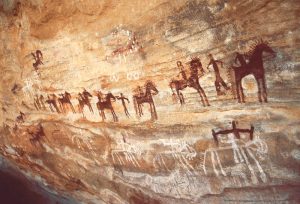Let’s have a look at some of the history.
With all the mundane preparations behind us – well, we still have to pack our bags, but that comes later -, it is time to focus on the contents, so to speak. I usually start by digging into the history of the country in some detail, but in this case that is not going to work. We’ll be visiting ten countries – excluding Nigeria – in eight weeks! Perhaps a regional approach works better, not in the least because all these countries’ histories are intimately linked.
There is no lack of books about African history in my library, admittedly most a bit dated, but good enough for the purpose of refreshing my knowledge. One of those, called A Short History of Africa, ‘short’ in this case meaning slightly over 300 densely written pages, was given to me in 1991, by my then girlfriend, now wife Sofia, who wrote in it that, maybe, one day we could explore this continent together. Well, it has taken over 30 years, but there we go!

trade across the Sahara, depicted in rock paintings in Mauretania (source: https://africanrockart.org/mauritania/)
Obviously, the history of Africa, even with a focus on West Africa alone, is far too complex to summarise in a few blog entries. For starters, this is where history began: one of our closest ancestors – so-called Australopithecus afarensis, better known by the poetic name of Lucy – originated from the continent. Later, even closer related species like homo habilis and homo erectus also developed firstly in Africa. Jump a couple of million years further, to the last few thousand years or so, and West Africa was a region where herders, farmers and traders lived in a symbiotic relationship. The herders needed the farmers to stall their cattle in the dry season, the farmers enjoyed the milk and the meat, and the traders connected the savannahs of the Sahel and the agricultural areas further south, at the edge of the rain forest, across the Sahara desert to the Mediterranean. Not only surplus produce was traded, the more profitable merchandise was gold, found in what is now Ghana, and slaves – raided further south and from communities that were non-Muslim, so fair game for the converted Islamists, a religion that expanded ever further south.
Note that in these days, the main trade routes were north-south, and the main population centres were inland – this would change with the arrival of Europeans in the 15th and 16th Century, which promoted not only population concentration along the coast, but also the emergence of east-west trading. Indeed, initially mostly slaves.

ivory trade (picture from https://african.business/2021/10/trade-investment/a-short-history-of-african-trade/)

the slave trade, from a 1859 wood engraving with modern colouring (source: https://www.blackhistorymonth.org.uk/article/section/history-of-slavery/africa-before-transatlantic-enslavement/)
When the first European appeared along the West African coast, in the form of the Portuguese halfway the 15th C, they knew better than to venture inland. They set up several trade stations and forts, from where they traded gold, ivory, pepper and slaves. The first documented slave shipment (by the Spanish, in fact) was from 1502, from Cameroon to the Caribbean – which is quite amazing, given that Columbus only discovered America ten years earlier. These early traders may not have been aware that West Africa, at the time, was home to several large empires, further inland.
Europeans referred to the coastal area as Guinea, and made a distinction between Upper Guinea, the stretch from present day Mauretania to Sierra Leone, essentially the north-south coast line, and Lower Guinea, from Sierra Leone to Cameroon, ie mostly the west-east coast line. Inland from Upper Guinea was what is confusingly called Sudan, located much further west than present-day country Sudan. At the time, this was the area of the Songhai Empire, one of the largest and most powerful in West Africa during the 16th century. It was located in what is now Mali, Niger, and Nigeria, and it controlled trade routes along the Niger River.
The Lower Guinea area was home to the impressive 16th and 17th C kingdoms of Dahomey and Benin, but also the Ashanti, the Oyo empire of the Nigerian Yoruba, and several more. Dahomey, for instance, was a highly centralized and militaristic kingdom located in present-day Benin and was known for its powerful army, which included a regiment of female warriors known as the Dahomey Amazons. Confusingly, the Benin empire was a well-developed and sophisticated kingdom located in present-day Nigeria, and known for its art, including bronze sculptures and intricate ivory carvings.
Not only the Spanish followed the Portuguese to West Africa, also the Brits, the French and the Dutch – and there were even Danish and Swedish establishments. Yet, for hundreds of years, these contacts were purely trade related, along the coast, whilst the Africans ensured that they maintained control over the interior trading routes. There was no political interest, there were no colonies, on the contrary, the European powers were reluctant to accept responsibility for governance. Something that acutely changed at the end of the 19th Century. (see 19 Feb.)










